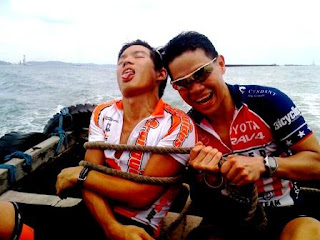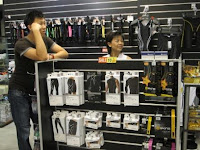A Case Study:
The Development of Good Running Technique at Track Attack
Shem Leong
As the fore-foot versus mid-foot versus bare-foot debate rattles on amongst a background of articles, scientific research and specialist opinions, I have clearly noticed a pattern in the development of a more efficient stride amongst the regular runners at our weekly “Track Attack” sessions.
To stake my ground, I believe that it is not which part of the foot that strikes the ground 1st that is consequential to an efficient stride, but rather, where, in relation to the hip the foot strikes that makes the biggest difference. This is nothing new; the momentum killing, braking forces that result from a foot strike in front of the hip is well documented and my runners have experienced marked improvement by learning to shift their strike-point rearwards, from in front of their hip to directly underneath it.
Achieving this, however, is much more involved than simply reminding my runners to “Drive your elbows” and “Run Tall” (although, to the outsider, this may appear to be the case if you drop in one of our sessions). To understand the wisdom behind these 2 adages its best to dissect and compare a typical untrained runner’s stride with that of an elite runner’s- Read on!
An untrained runner, their style and common problems with it
Many novice and intermediate runners, before they are turned on to the finer details of beautiful running, are unaware of the little intricacies that make up efficient and functional running form. Most come in with a natural, default stride rate anywhere between 76- 84 strides per minute and their thick heeled running shoes (more rubber means they’ll last longer, more foam means they provide a more cushioned ride, right?) make it comfortable to reach out beyond their hip and land squarely on their heel – a typical over-strider.
On hearing about the “Stride Rate” Phenomenon, (the more steps you take per minute, the faster you go- isn’t that pure genius?) they experiment with swinging their legs forwards and backwards more purposefully, attempting to emulate the smooth and graceful “float” of elite runners. This is where the real trouble starts. To the untrained runner, it’s instinctive (but erroneous) to use their legs as shock absorbers, scooting their legs furiously while “sitting down” on their pelvis to lessen the impact in an attempt to achieve that effortless and comfortable ride. The overall effect has them in an exaggerated shuffle- as if they were training for speed walking. You’ve seen them, maybe you’re one of them!
While increasing your stride rate is a step in the right direction, and the initial correction made above does go part of the way to retraining a runner’s neuromuscular firing patterns, many runners stop here, having found their “new and improved style”. Yes- running a higher stride rate does inadvertently shorten your stride length and facilitate a more “under the hip” foot strike- but without the complimentary ballistic strength, proper posture and a deeper understanding of running biomechanics and how to apply it, many high stride rate runners cease to develop beyond this.
An elite runner- their style and how they achieve it
In fact, elite runners apply a lot of power at the exact moment of strike, and transition much more quickly than the rest of us to a relaxed “flight phase” in between strikes. Because they are able to generate more power, elite runners spend much more hang time in the air moving forward than the common runner; this is what gives the impression of graceful flight. Ever wonder why, in still shots, they are always captured majestically flying through the air, 12 inches off the ground, while the rest of us are caught unglamorously flat footed, mid strike or, at best, hovering a few centimetres above the ground just before an impending heel-strike?
Top runners are able to cover larger distances between foot strikes. Contrary to popular belief, this means that they actually have a substantial stride length. Many runners emulate their heroes by over-extending their lower leg, reaching forward to cover more ground prior to foot-strike, which has their foot touching down in front of their hip- a typical over-striders gait. The difference in elite runners is that their ground is covered “flying” through the air after an extremely quick and powerful strikes under the hip.
This part of their super-power can be explained by their ballistic supremacy- the ability for their highly developed muscles (calves and gluteals in particular) to contract much more explosively and repeatedly for a longer time before fatigue. The result is that each powerful strike propels them for a greater distance in the air before they strike and push off again on the other leg.
Coupled with a high stride rate, this translates to the beautifully efficient running and tremendous speeds of top athletes. One of the biggest tell-tale differences is the amount of time that their foot is in contact with the ground; for every nanosecond that a foot is planted on the ground, not moving, precious kinetic energy is being dissipated into the ground causing deceleration. Top runners are able to 1) minimise this contact time and 2) produce a tremendous amount of forward propulsion in that reduced time while untrained runners lose a lot speed here.
Putting it all together
So then what does this mean for us- the everyday runner who dreams of running more efficiently, more beautifully and faster, in our journey to chase down PB’s. To simply state that increasing your stride rate will make you a quicker runner is to over-simplify a complex developmental process that comprises neurological re-wiring, proper muscular strengthening and learned sensitivity to accurate proprioception (awareness of body/limb positions while moving through space and time). We need to pick apart the problem and take baby steps in each direction.
To clarify, I do believe that “driving your elbows” to increase stride rate and shorten your stride is the correct 1st step to take. This addresses over-striders in particular and teaches us how to land “under” the hip as opposed to “in front” of it.
Concurrently improving the ballistic capability of the running specific muscles through Plyometrics and hill reps gives us that extra “snap” at the moment of launch so that we are able to cover more distance gliding through the air. Biomechanically speaking, “running tall” allows for a more pronounced knee lift following the swing-through phase of the stride. This gives the runner extra leverage to slam our foot powerfully into the ground. The right drills will give our brains a good impression to follow.
Needless to say, we need to back this “impact-heavy style of running” up with the correct functional strengthening exercises. These will stabilize the joints and give our body the toughness to withstand greater forces at higher intensity. For example, external rotators of the knee and hip abductors are important muscle groups for keeping the pelvis stable during alternating arm and leg movements.
Last but not least, a dedicated core work routine that strengthens the deep abdominals is priceless because this will allow you to run “tall” for longer, holding perfect posture and mid-section form. An “engaged” torso, in a state of constant rotational torsion, transforms your trunk into a taut spring which is a much more effective means for us to harness the energy returning to us after each foot-strike.
So the next time you hear me call out “Drive your elbows” or “Run Tall”, you’ll know exactly what I’m talking about.
** See you at track! **
 |
| Air Meb |
 |
| I bet Haile can dunk. |




















































